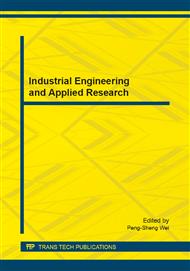[1]
Y. Bartal, S. Leonardi, A.M. Spaccamela, J. Sgall and L. Stougie, Multi-processor Scheduling with Rejection, SIAM Journal on Discrete Mathematics, 13 (2000), 64-78.
DOI: 10.1137/s0895480196300522
Google Scholar
[2]
L.Q. Zhang, L.F. Lu, J.J. Yuan, Single Machine Scheduling with Release dates and Rejection, European Journal of Operation Research, 198 (2009), 975-978.
DOI: 10.1016/j.ejor.2008.10.006
Google Scholar
[3]
I. Kacem and A.R. Mahjoub, Fully Polynomical Time Approximation Scheme for the Weighted Flow-time Minimization on Single Machine with a Fixed Non-availability Interval, Computer & Industrial Engineering, 56 (2009), 1708-1712.
DOI: 10.1016/j.cie.2008.09.042
Google Scholar
[4]
I. Kacem, Approximation on Algorithms for the Makespan Minimization with Positive Tails on a Single Machine with a Fixed Non-availability Interval, Journal of Combinatorial Optimization, 17 (2009), 117-133.
DOI: 10.1007/s10878-007-9102-4
Google Scholar
[5]
H. Kellerer, M.A. Kubzin and V.A. Strusevich, Two Simple Constant Ratio Approximation Algorithms for Minimize the Total Weighted Completion Time on a Single Machine with a Fixed Non-availability Interval, European Journal of Operational Research, 199 (2009).
DOI: 10.1016/j.ejor.2008.11.003
Google Scholar
[6]
G. Mosheiov and A. Sarig, Scheduling a Maintenance Activity to Minimize Total Weighted Completion Time, Computers and Mathematics with Applications, 57 (2009), 619-623.
DOI: 10.1016/j.camwa.2008.11.008
Google Scholar
[7]
L.F. Lu, L.Q. Zhang and J.J. Yuan, The Unbounded Parallel batch Machine Scheduling with Release Dates and Rejection to Minimize Makespan, Theoretical Computer Science, 369 (2008), 283-289.
DOI: 10.1016/j.tcs.2008.02.015
Google Scholar
[8]
L.Y. Kang and C.T. Ng, A Fully Polynomial-time Approximation Scheme for Parallel-machine Scheduling with Deteriorating Jobs, International Journal of Production Economics, 109 (2007), 180-184.
DOI: 10.1016/j.ijpe.2006.11.014
Google Scholar
[9]
J.K. Lenstra, A.H. G Rinnooy Kan and P. Brucker, Complexity of Machine Scheduling Problems, Annals of Discrete Mathematics 1 (1977), 343-362.
DOI: 10.1016/s0167-5060(08)70743-x
Google Scholar


